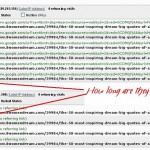Last updated on February 26th, 2023 at 01:24 am
It is my feeling that most of the general public has no idea of the time and effort that goes into creating a blog post that goes viral, or any blog post for that matter.
It’s okay. Be mad at me for putting that right out there in your face.
But crafting a blog post involves so much more than simply putting words down. It involves a string of steps that must be followed in order to achieve any sort of blogging success. Deviate from the steps, and you’ve just wasted 4-8 hours of your life each time you decide to “blog.”
If you do blogging right, it’s like writing a term paper every time you sit down to do it.
Sorry, but it’s true. Great bloggers who do this right are just sick enough to think of their blogging efforts as fun.
Before you judge me too harshly for my comments, let me explain what needs to go into every single blog post for the chance of having the world think that your blogging deserves recognition.
I also want those of you who roll your eyes at blogging to understand the amount of work that is involved in creating something for you to read on the Internet.
This is how to write a blog post
1. The blogger decides on a niche story.
This means that the blogger must resist the urge to write about how the San Francisco Giants just won the World Series and how they are moved to write the story…but instead… the blogger stays the course and writes about the subject at hand: I.e. their niche. We must drown out the urge to write whatever comes to our head and focus on what we should be writing about, as well as what the reader wants to read.
This is not easy.
Like tonight, I really wanted to tell the story of how my son finally made a major football play that change the course of a big game, thus furthering his dream, except, how does this story relate to my dream of having a top blog?
It doesn’t.
And sometimes writing about kids can turn readers off. So I have to stop myself and ask, “Will my readers want to hear this from me?”
When in doubt, follow James Patterson’s writing advise, “I’m always pretending that I’m sitting across from somebody. I’m telling them a story, and I don’t want them to get up until it’s finished.”
2. The blogger then writes the rough draft.
Writing a first draft that gets all your thoughts down about a particular story is the essential first step toward drafting a popular post. You get everything out that is in your heart along with what you’ve researched on the subject (yes, there is research), giving little value to grammar or structure in order to get everything out.
As Anne Lamott wrote in her book, Bird By bird, “For me and most of the other writers I know, writing is not rapturous. In fact, the only way I can get anything written at all is to write really, really shitty first drafts.”
Then a blogger will let this rough draft sit for 4 days. The idea is to let your writing sit like you’d let quality meat cure or a fine wine age. And you don’t look at it until you have the time and space to mold the story.
From Stephen King, “[After] recuperation time, you’ll also be able to see any glaring holes in the plot or character development. I’m talking about holes big enough to drive a truck through. It’s amazing how some of these things can elude the writer while he or she is occupied with the daily work of composition.”
3. The blogger begins the editing process.
Gulp. This is where the rubber meets the road. It is the best idea to scrap your first one or two paragraphs because somewhere in there your real story actually begins. You read it out loud as if it is a play and begin to work with the words you’ve vomited from your head.
Then maybe you pass it to a beloved editor-friend who points out where your points make no sense. You correct. You correct again. You read it backward starting from the last sentence and correct it again. And when you get it to where you think you want it, you…
Revise it.
As Stephen King wrote in his book, “On Writing,” “Mostly when I think of pacing, I go back to Elmore Leonard, who explained it so perfectly by saying he just left out the boring parts. This suggests cutting to speed the pace, and that’s what most of us end up having to do (kill your darlings, kill your darlings, even when it breaks your egocentric little scribbler’s heart, kill your darlings)…I got a scribbled comment that changed the way I rewrote my fiction once and forever. Jotted below the machine-generated signature of the editor was this mot: “Not bad, but PUFFY. You need to revise for length. Formula: 2nd Draft = 1st Draft – 10%. Good luck.”
4. The blogger corrects the final draft to be read on the Internet.
As renowned Internet guru, Jakob Nielsen will tell you – people don’t read on the web.
He says, “People rarely read Web pages word by word; instead, they scan the page, picking out individual words and sentences.”
So you edit to make sure your paragraphs are three sentences or less and you pull key phrases out into their own sentence for dramatic effect. The post begins to read like a poem. You scan your own post to see if you are engaging your reader.
5. The blogger researches a keyword phrase that best describes the post.
Now you’ve written a masterpiece, but will anyone find it in order to read it? Just because you’ve written the next War and Peace doesn’t mean that anyone will read it. This has nothing to do with talent, but everything to do with how people type phrases into search engines to find what they want to read.
Some writers do this research first, while others do it when they are done writing their posts. Many will use Google’s Keyword Tool to find the exact phrase readers will type to search, while others use popular keywords they’ve discovered people use to find their site.
Once you’ve discovered the best phrase that describes what you just wrote, you go back through your post to see if you can add this phrase to the beginning of your title, your opening sentence, a couple of times within the post, and at the end. Often this is where a writer discovers that they need to add more to their post to wrap up a point.
Remember the wise words of Nicholas Sparks, “Publishing is a business. Writing may be art, but publishing, when all is said and done, comes down to dollars.”
6. The blogger plays with the title.
Titles are everything on the Internet. They are what people read to determine whether or not your post is worth clicking on in search results. And that engaging title can only be 60 characters long. They should include some sort of call to action and your keyword phrase while best describing what the reader can expect from your post.
Great titles are an art form and can bring life or death to your post.
7. Then images become everything.
Images make the difference in people staying with your story and how your story can be shared through social networks. Your images need to make the reader feel part of the story that you are telling.
Readers love it most when bloggers share images from their real life. They need to be sized properly, placed strategically to help the reader stay with your story, and they need to be named and configured for search.
An image is more than just an image to your post. It’s the image that is shared on Facebook, it’s the image that is found in Google search, it’s the image that is pinned on Pinterest, and it’s the image that supports your story.
Your images need to have real names before they are uploaded and placed like a graphic designer placed them. Not easy. They also need to be post-processed and configured for viewing on the Internet.
Think about what Ansel Adams had to say about photographs,“When words become unclear, I shall focus with photographs. When images become inadequate, I shall be content with silence.”
8. The blogger adds the finishing touches.
You link out to sites that support your story. You check your spelling. You add H2 tags or bold subtitles to keep your post flowing. You add keywords and tags for your story and match them to a category. You re-read it again and schedule it to go live.
9. The blogger does not stop here.
Once it goes live, you market your post to the world. You share it with your family and friends, with your email list, on Twitter, on Facebook, on Pinterest and anywhere else you think people will be interested.
This entire process can take 3 – 8 hours –every single time you create a story for the Internet. And if you get lucky, and your timing is right, it’s very possible your story will get shared among a larger circle of readers and go viral. And if you are like many bloggers, most of the time you are doing this for free — for the chance to be discovered and to change your life.

Catherine Hughes is an accomplished magazine columnist, content creator, and published writer with a background as an award-winning mom blogger. She partners with companies to create captivating web content and social media stories and writes compelling human interest pieces for both small and large print publications. Her writing, which celebrates the resilience and achievements of Northern California’s residents, is featured in several magazines. Beyond her professional life, Catherine is passionate about motherhood, her son, close friendships, rugby, and her love for animals.
Note: Articles by Catherine may contain affiliate links and may be compensated if you make a purchase after clicking on an affiliate link.




